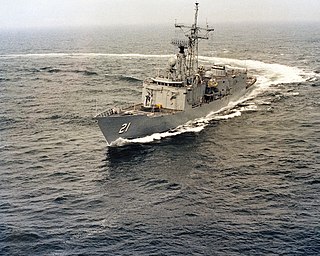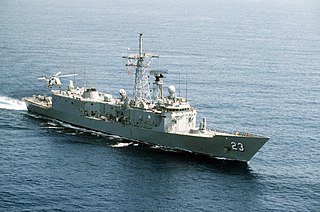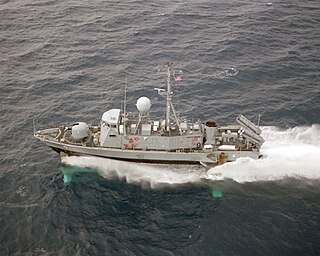
USS Samuel Eliot Morison (FFG-13), was the seventh Oliver Hazard Perry-class frigate in service with the United States Navy. She was named for Rear Admiral Samuel Eliot Morison (1887–1976), one of America's most distinguished naval historians, who wrote more than 40 books on naval history.

USS Wadsworth (FFG-9), third ship of the Oliver Hazard Perry class of guided-missile frigates, was named for Commodore Alexander S. Wadsworth (1790–1851). She was the third US Navy ship named Wadsworth. She was the second "short-hull" OHP frigate 445 ft (136 m) long. Commissioned in 1980, she served in the US Navy until 2002. Upon decommissioning she was immediately turned over to the Polish navy, where she now serves as ORP Generał Tadeusz Kościuszko.

USS John A. Moore (FFG-19), eleventh ship of the Oliver Hazard Perry class of guided-missile frigates, was named for Commander John Anderson Moore (1910–1944). Ordered from Todd Pacific Shipyards, Los Angeles Division, San Pedro, California on 28 February 1977 as part of the FY77 program, John A. Moore was laid down on 19 September 1978, launched on 20 October 1979, and commissioned on 14 November 1981.

USS Flatley (FFG-21) was the thirteenth ship of the Oliver Hazard Perry class of guided-missile frigates. She was the first ship of the U.S. Navy to be named for Vice Admiral James H. Flatley (1906–1958), a leading Naval Aviation tactician from World War II who flew the Grumman F4F Wildcat in the Battle of Coral Sea and subsequently commanded the VF-10 Grim Reapers taking them into combat for the first time.

USS Fahrion (FFG-22), fourteenth ship of the Oliver Hazard Perry-class of guided-missile frigates, was named for Admiral Frank George Fahrion (1894–1970).

USS Lewis B. Puller (FFG-23) was the fifteenth ship of the Oliver Hazard Perry class of guided-missile frigates in the United States Navy. She was the first US Navy ship to be named for United States Marine Corps Lieutenant General Lewis B. "Chesty" Puller (1898–1971). Ordered from Todd Pacific Shipyards, Los Angeles Division, San Pedro, California on 28 February 1977 as part of the FY77 program, Lewis B. Puller was laid down on 23 May 1979, launched on 15 March 1980, and commissioned on 17 April 1982. Decommissioned and stricken on 18 September 1998, she was transferred to Egypt the same day as Toushka (F906).

USS Jack Williams (FFG-24), sixteenth ship of the Oliver Hazard Perry-class of guided-missile frigates, was named for Pharmacist's Mate Third Class Jack Williams, who was posthumously awarded the Medal of Honor for his heroism in the Battle of Iwo Jima.

USS Copeland (FFG-25) was the seventeenth ship of the Oliver Hazard Perry class of guided-missile frigates in the United States Navy. She was named for Rear Admiral Robert W. Copeland (1910–1973).

USS Mahlon S. Tisdale (FFG-27), nineteenth ship of the Oliver Hazard Perry class of guided-missile frigates, was named for Vice Admiral Mahlon Street Tisdale (1890–1972). Ordered from Todd Pacific Shipyards, Los Angeles Division, San Pedro, California, on 23 January 1978 as part of the FY78 program, Mahlon S. Tisdale was laid down on 19 March 1980, launched on 7 February 1981, and commissioned on 27 November 1982.

USS Reid (FFG-30), twenty-second ship of the Oliver Hazard Perry-class of guided-missile frigates, was named for Sailing Master Samuel Chester Reid (1783–1861).

The Pegasus-class hydrofoils were a series of fast attack patrol boats employed by the U.S. Navy. They were in service from 1977 until 1993. These hydrofoils carried the designation "PHM" for "Patrol Hydrofoil, Missile." The Pegasus-class vessels were originally intended for NATO operations in the North Sea and Baltic Sea. Subsequently, participation by other NATO navies, including Germany and Italy, ceased and the U.S. Navy proceeded to procure six PHMs, which were highly successful in conducting coastal operations, such as narcotics interdiction and coastal patrol, in the Caribbean basin.
Five ships of the United States Navy have borne the name USS Hercules, after Hercules, the Roman name version of Heracles. Hercules also is the name of a constellation.
USS Taurus is a name used more than once by the U.S. Navy, after the constellation Taurus:

USS Pegasus (PHM-1) was the lead ship of her class of hydrofoils operated by the United States Navy. Pegasus-class vessels were designed for high speed and mobility, and carried a powerful armament for their size.

USS Gemini (PHM-6) was the final ship of her class of hydrofoils operated by the U.S. Navy. She was named for the constellation.

USS Aries (PHM-5) was the fifth ship of her class of hydrofoils operated by the United States Navy. Pegasus class vessels were designed for high speed and mobility. Despite being small in size, they carried a large 76 mm gun. Aries was named for the constellation.

The second USS Aquila (PHM-4) was the fourth ship of her class of hydrofoils operated by the United States Navy. Pegasus class vessels were designed for high speed and mobility, and carried a powerful armament.

USS Taurus (PHM-3) was the third ship of her class of hydrofoils operated by the United States Navy. Pegasus class vessels were designed for high speed and mobility, and carried a powerful armament. The ship was named for the constellation Taurus.

USS De Wert (FFG-45), an Oliver Hazard Perry-class frigate, was a ship of the United States Navy. She was named for Hospitalman Richard De Wert (1931–1951). De Wert posthumously received the Medal of Honor for his heroism while serving with the 7th Marines during the Korean War.

Boeing has designed and built several hydrofoil craft for both military and civilian use.
















